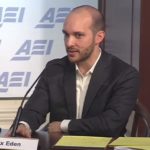In the vision laid out by their strongest supporters, education savings accounts have the potential to revolutionize public education, giving parents direct control of funding and allowing them to assemble customized educational programs for their children, buying services from private schools, public schools, home-school curriculum providers, and more. Plain-vanilla school choice could start to seem passé. Parents could save money left over at the end of the school year for future expenses, including college, giving them a greater incentive to shop around and economize.

That’s the theory. On Wednesday, during an American Enterprise Institute event that billed ESAs as “the new frontier in school choice,” Max Eden of the Manhattan Institute said he wanted to throw some “cold water” on it. The programs might work for some students — like those with special needs — who tend to qualify for larger weighted per-pupil funding, and for whom the benefits of a fully customized education are obvious. But when it comes to their potential to totally transform the broader education system, Eden said he was skeptical.
“There’s a sense throughout [the nine papers presented at AEI’s event] that this will explode in numbers and in scope, and I’m very skeptical of that,” he said. ESAs may be more likely to create “a marginal system that will provide marginal support to relatively marginalized students.”
In the end, he said, “The prime benefit of ESAs may help make the world even safer for charters.” If more legislatures pushed for them, that might broaden the window of political possibility for educational choice. And ESAs could provide new options for children, like those with special needs, whom charter schools often struggle to serve well. “I don’t know that I see [ESAs] being an explosive and revolutionary thing,” Eden said.
Matthew Ladner, a senior policy adviser to the Foundation for Excellence in Education who’s been a leading proponent of ESAs as a concept, said Eden made some valid points.“The reality is that ESAs are not going to take over the world any time soon,” Ladner said, but if they ever will, it will only happen if some states start trying the programs in the real world. To work through the challenges that arise when parents start purchasing a vast array of different educational services with public funding, he said, “We need to actually have programs.”
Of the five existing state ESA programs, three, including Florida’s Gardiner Scholarships, are aimed exclusively at children with special needs. Arizona’s is available to special needs students and a few other targeted groups. The only program with universal eligibility is Nevada’s. It’s currently in legal limbo, but notably, it was created in a state that is growing rapidly and struggling to build schools fast enough to accommodate a constant influx of new students.
Ladner said that if lawmakers in states like Florida, Tennessee and Mississippi were to keep their programs confined to students with special needs, they’ll still have changed thousands of children’s lives for the better. (Florida’s Gardiner scholarships serve more than 4,000 students this school year, and are administered by organizations like Step Up For Students, which publishes this blog).
“These programs have a huge amount of value to some of the most disadvantaged students in the public system,” Ladner said.
And Eden, the skeptic, said he sees another opportunity for education savings accounts: Publicly funded preschool. The ecosystem around programs like Florida’s Voluntary Pre-K already includes a wide range of education providers, many of them private. And bipartisan political momentum to expand funding and access in those programs is building in different parts of the country.
“Whereas I have a very difficult time imaging this revolutionizing K-12, I could definitely imagine this being an alternative to Pre-K expansion for 4-year-olds,” he said. And that could serve as a proving ground for the ESA concept, if it eventually were to grow.


